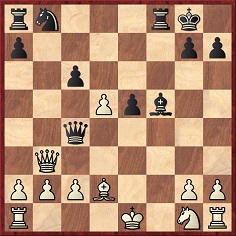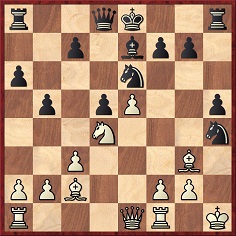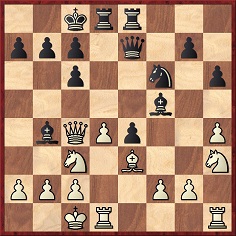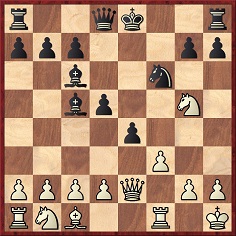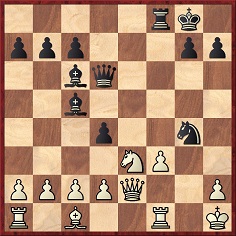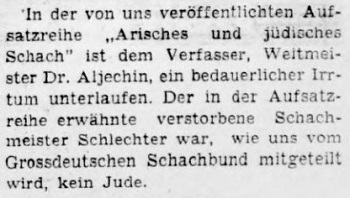Chess Notes
Edward Winter
When contacting us by e-mail, correspondents are asked to include their name and full postal address and, when providing information, to quote exact book and magazine sources. The word ‘chess’ needs to appear in the subject-line or in the message itself.
| First column | << previous | Archives [145] | next >> | Current column |
10047. Atpūta
Jan Kalendovský (Brno, Czech Republic) sends two items from the Latvian magazine Atpūta:
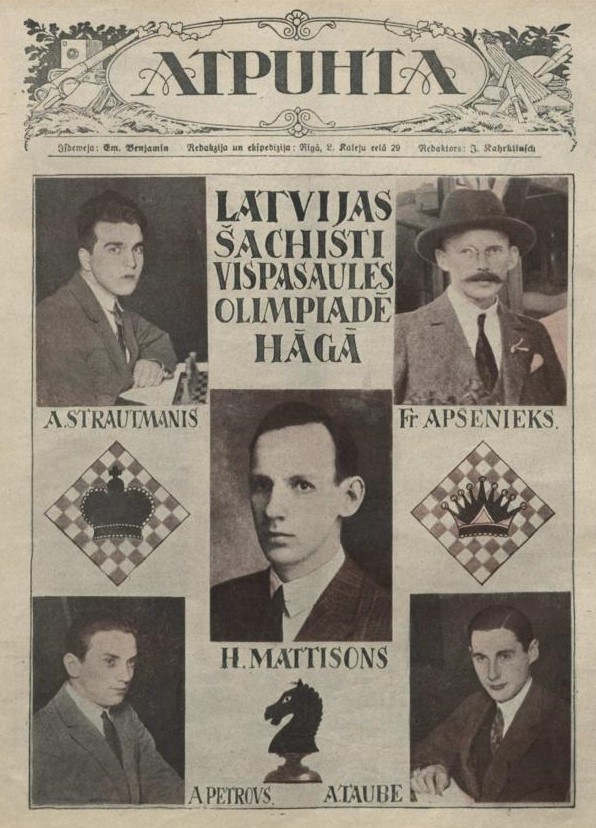
10 August 1928, page 3
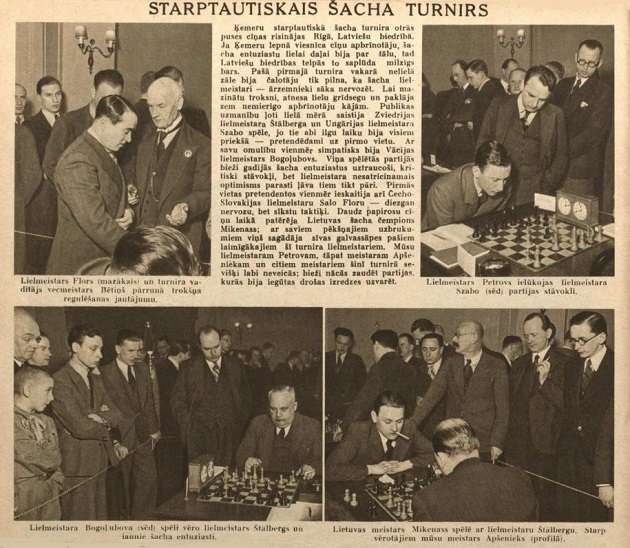
17 March 1939 (unnumbered page)
10048. Chess-Nuts
From page 22 of a copy of an unidentified twentieth-century scrapbook we have plucked up the courage to make these additions to the feature article Chess Corn Corner:

10049. A. de Rivière v M. Wyvill
Gerard Killoran (Ilkley, England) provides this game from Löwenthal’s column in the Era, 18 December 1864, page 4:
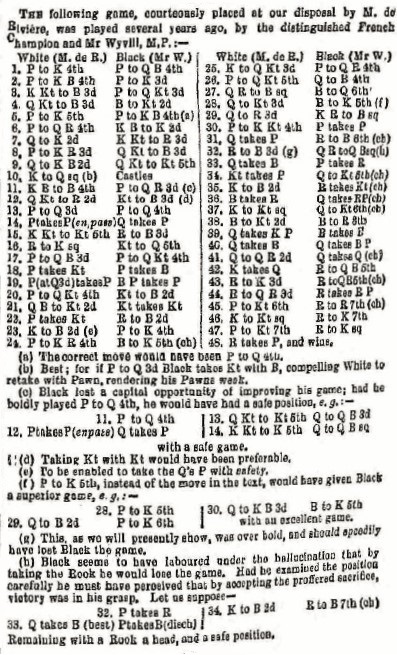
1 e4 c5 2 f4 e6 3 Nf3 b6 4 Nc3 Bb7 5 e5 f5 6 a4 Be7 7 Qe2 Nh6 8 h3 Nc6 9 Qf2 Nb4 10 Kd1 O-O 11 Bc4 a6 12 Na2 Nc6 13 d3 d5 14 exd6 Qxd6 15 Ng5 Rf6 16 Re1 Nd4 17 c3
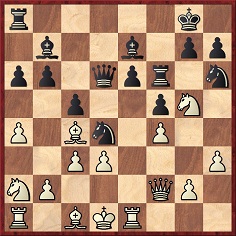
17...b5 18 cxd4 bxc4 19 dxc4 cxd4 20 b4 Nf7 21 Bb2 Nxg5 22 fxg5 Rf7 23 Kc2 e5 24 h4 Be4+ 25 Kb3 a5 26 b5 Qc5 27 Rac1 Bd3 28 Qg3 Be4 29 Qh3 Rff8 30 g4 fxg4 31 Qxg4 Rf3+
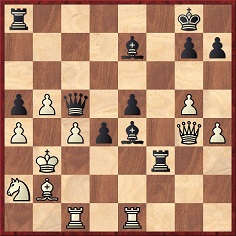
32 Rc3 Rc8 33 Qxe4 dxc3 34 Nxc3 Qb4+ 35 Kc2 Rxc3+ 36 Bxc3 Qxa4+ 37 Kb1 Qb3+ 38 Bb2 Ba3 39 Qxe5 Bxb2 40 Qxb2 Qxc4 41 Qa2 Qxa2+ 42 Kxa2 Rc4 43 Re3 Ra4+ 44 Ra3 Rxh4 45 b6 Rh2+ 46 Kb1 Re2 47 b7 Re8 48 Rxa5 ‘and wins’.
The occasion was not specified, but Mr Killoran suggests, based on the lengthy material on page 2 of the Royal Leamington Spa Courier and Warwickshire Standard, 30 June 1855, that the game was played in Leamington in 1855. See too pages 255-267 of the Chess Player’s Chronicle, 1855.
Both de Rivière and Wyvill are in the Leamington, 1855 illustration discussed in Pictures of Howard Staunton.
10050. Capablanca’s resignation letter (C.N. 10022)
Concerning Capablanca’s letter to Alekhine dated 29 November 1927, which was shown in C.N. 10022, Thierry Lafargue (Mont de Marsan, France) draws attention to an article entitled ‘Le séjour de Karpov à Paris’ by Roland Lecomte on page 197 of Europe Echecs, July 1976. It recorded that at a reception in his honour in Paris on 2 June 1976 Karpov was presented with the original letter, which had been bequeathed to the Ligue de l’Ile-de-France by its late Honorary President, Louis Sol. The document ‘est destiné à être la possession du champion du Monde en titre’.
The relevant parts of the report:
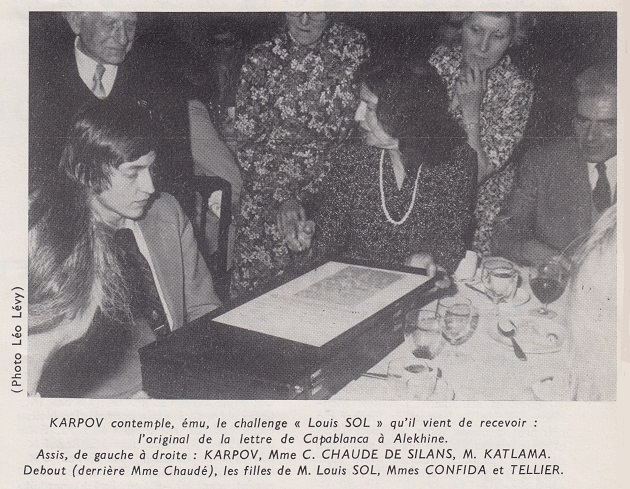

Mr Lafargue asks where Capablanca’s letter is today.
10051. Alekhine’s Defence
Eduardo Bauzá Mercére (New York, NY, USA) provides an addition (S.L. McCalla-L.D. Barbour, Philadelphia, 17 April 1887) to our small collection of pre-Alekhine specimens of Alekhine’s Defence. It was published on page 16 of the New Orleans Times-Democrat, 1 May 1887:
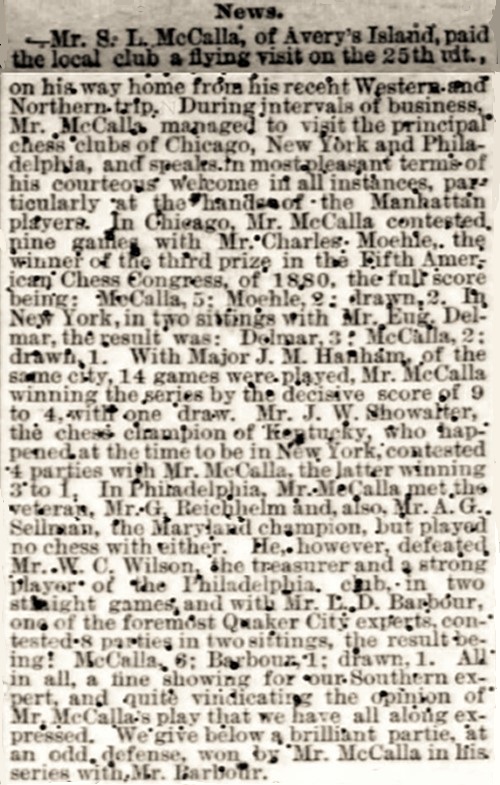

1 e4 Nf6 2 e5 Ne4 3 d3 Nc5 4 d4 Nca6 5 f4 e6 6 Nc3 Bb4 7 Bd2 c5 8 d5 Bxc3 9 Bxc3 exd5 10 Qxd5 O-O 11 O-O-O Qe7 12 a3 Qe6 13 Qe4 f5 14 Qa4 Kh8 15 Nf3 h6 16 Rd6 Qe7 17 g3 b6 18 Nh4 Kh7 19 Bg2 Nc6 20 Ng6 Qe8 21 Nxf8+ Qxf8 22 Bxc6 dxc6 23 Qxc6 Rb8 24 Rhd1 Bb7
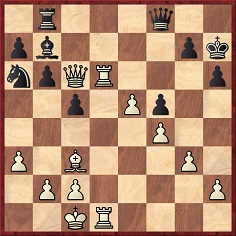
25 Rxh6+ gxh6 26 Rd7+ Kh8 26 Qg6 Resigns.
10052. Sacrifices
An observation by Wolfgang Heidenfeld on page 16 of Lacking the Master Touch (Cape Town, 1970):
‘Young players usually see the be-all and end-all of chess in sacrifices (the same, incidentally, applies to some that are not so young. I well remember how, the first time I ever took part in a simultaneous display – against Bogoljubow – a white-haired old geezer went round the room, asking solicitously at every board: “Has the master sacrificed yet?”)’
10053. Rubinstein in Burnley
From Gerard Killoran (Ilkley, England) comes a report about a 22-board simultaneous exhibition by Akiba Rubinstein in Burnley on 12 February 1925, from page 6 of the Burnley News, 18 February 1925:
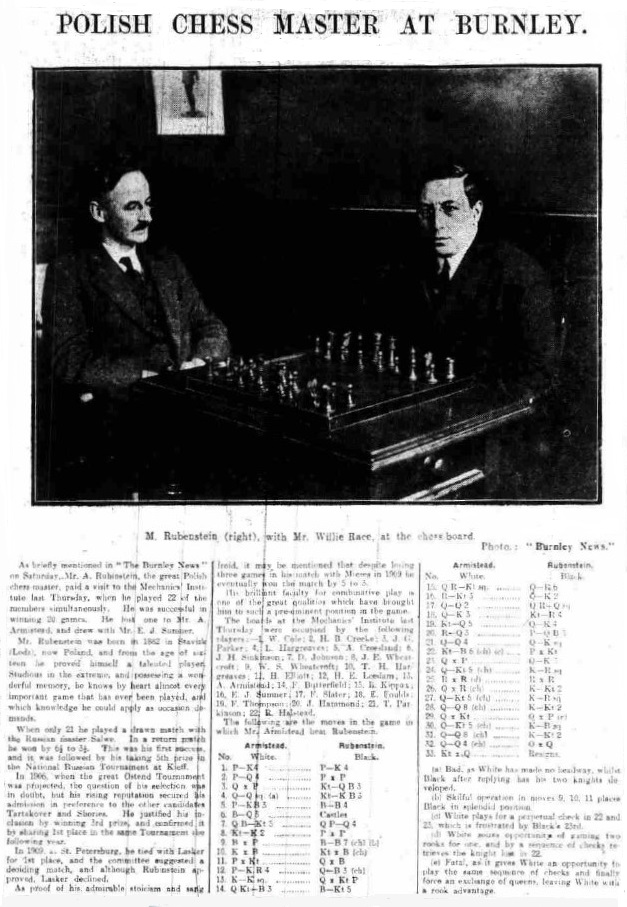
A. Armistead v A. Rubinstein:
1 e4 e5 2 d4 exd4 3 Qxd4 Nc6 4 Qd1 Nf6 5 f3 Bc5 6 Bd3 O-O 7 Bg5 d5 8 Ne2 dxe4 9 Bxe4
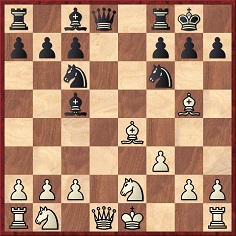
9...Bf2+ 10 Kxf2 Nxe4+ 11 fxe4 Qxg5 12 h4 Qf6+ 13 Ke1 Qxb2 14 Nbc3 Bg4 15 Rb1 Qa3 16 Rb3 Qe7 17 Qd2 Rad8 18 Qe3 Na5 19 Nd5 Qe5 20 Rd3 c6 21 Qd4 Qe8
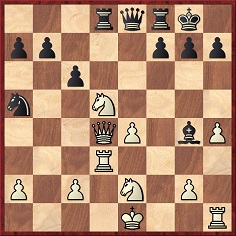
22 Nf6+ gxf6 23 Qxf6 Qe6 24 Qg5+ Kh8 25 Rxd8 Rxd8 26 Qxd8+ Kg7 27 Qg5+ Kh8 28 Qd8+ Kg7 29 Qxa5 Qxe4 30 Qg5+ Kf8 31 Qd8+ Kg7 32 Qd4+ Qxd4 33 Nxd4 Resigns.
We note that the photograph and game (with almost identical annotations) had been given on page 15 of the Burnley Express and Clitheroe Division Advertiser, 14 February 1925. It stated that Willie Race ‘acted as interpreter, as the chess master speaks no English’.
A slightly clearer version of the photograph of Race and Rubinstein:

10054. Alekhine and cats (C.N.s 4794, 5575, 8301 & 9778)
Peter Verschueren (Kudelstraat, the Netherlands) sends this cartoon by Jo Spier (1900-78) from page 11 of De Telegraaf, 16 December 1935:

The heading and caption:
At the most exciting moment in the most exciting game of the exciting Euwe-Alekhine match.
‘Mr Alekhine, them cat litter boys is askin’ if they can take the tray out.’
10055. Boris Karloff
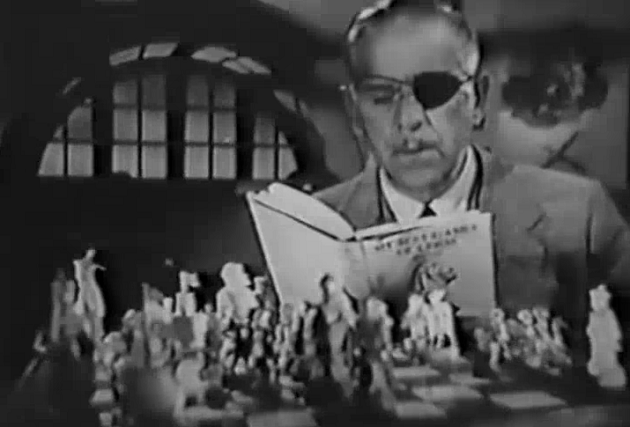
This screen-shot has been provided by Alan O’Brien (Mitcham, England) from the 1956 television programme Colonel March of Scotland Yard: The New Invisible Man. The episode can be viewed online, and the shot of Boris Karloff holding a chess book (which, our correspondent notes, appears to be My Best Games of Chess with the standard dust-jacket of Bell chess books), occurs at about 14’40”.
10056. Max Pavey (C.N. 10016)
C.N. 10016 asked whether confirmation can be found that Max Pavey’s death in 1957, at the age of 39, was caused by radioactivity. Pavey was an employee of the Canadian Radium and Uranium Corporation Laboratory in Mount Kisco, NY.
Ed Tassinari (Scarsdale, NY, USA) notes that the obituary of the co-founder of the company, Alexander Pregel, in the New York Times of 28 June 1998 stated:
‘In 1954 Canadian Radium and Uranium was reported to be one of the largest of the companies mining and refining radioactive ores. In 1957 it became the target of New York State’s first prosecution of a corporation for exposing employees to excessive radiation.
State Labor Department officials filed charges against Canadium Radium and Uranium, which pleaded guilty, in a court in Mount Kisco, NY, to permitting excessive radiation in a company plant in Mount Kisco. The plant processed radioactive materials for medical, research and industrial organizations.
But the judge in the case, Police Justice John F. Reed Jr, said nothing further could be gained by a fine. Therefore, he said, “The court suspends sentence”.
He also said: “The court notes that there has been no proof of any kind that the health of any person, either in or out of the plant, has been impaired in any way by the acts of the defendant, or that the health of the community has been in any way disturbed.”’
10057. Philidor: engraving (C.N. 10026) and death (C.N. 10046)
Manfred Mittelbach (Cape Town) reports that he owns a coloured version of the engraving of Philidor’s blindfold display in London in 1794:
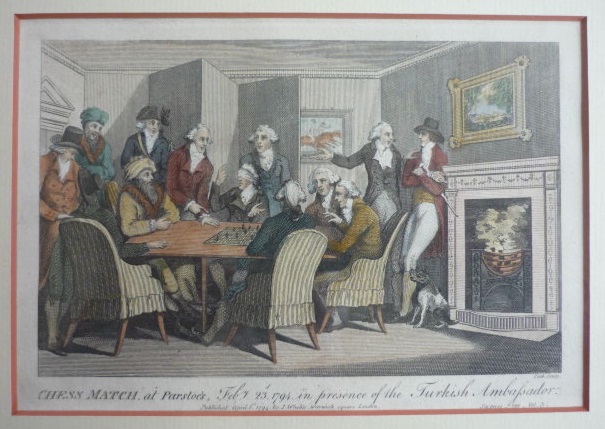

Our correspondent also quotes from a letter (London, 25 February 1794) written by Philidor to his wife:
‘J’ai jouée, samedi dernier deux parties sans voir a notre club, et l’ambassadeur turc, qui est résident ici, m’a honorer de sa présence et m’a fait dire par son interprete qu’il reviendroit une autre fois. Il a été très satisfait, ainsi que tout les spectateurs. Cela m’a valu, tous fraix fait, 6 guinées et quelques shillings.’
Source: page 181 of Philidor musicien et joueur d’échecs (Paris, 1995). Philidor’s spelling was not altered. A discrepancy is that ‘samedi dernier’ was 22, and not 23, February.
Mr Mittelbach also mentions that the engraving was published on page 16 of the Times, 7 September 1926, in conjunction with, on page 10, a lengthy article marking the bicentenary of Philidor’s birth.
That material reinforces our criticism of Charles Michael Carroll for writing on page 141 of Pour Philidor (Koblenz, 1994):
‘... during the first half of the twentieth century, Philidor was not a well-known figure in history. As far as I can determine, the 200th anniversary of his birth in 1926 went by totally unnoticed ...’
On page 8 of the Winter 1995 issue of Kingpin (see too page 280 of Kings, Commoners and Knaves and Chess Jottings) we quoted Carroll’s remark and commented:
‘To give just one straightforward refutation of that, the October 1926 BCM had a two-page article on Philidor by John Keeble whose first sentence referred to the bicentennial.’
The 1926 Times article was headed:
‘Danican Philidor
Anglo-French Chess Bicentenary
(From our chess correspondent.)’
The newspaper’s chess correspondent was Edward Samuel Tinsley.
The Times article is relevant to the discussion about the date of Philidor’s death (C.N. 10046). E.S. Tinsley wrote:
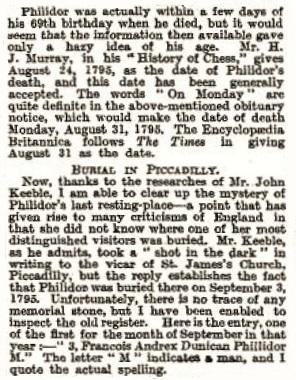
John Keeble referred to that passage at the end of his above-mentioned article published on pages 434-436 of the October 1926 BCM:

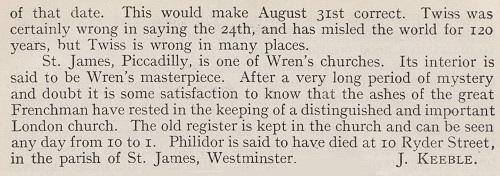
The latest word on Philidor’s resting place is the article referred to in C.N. 10046, ‘Sleuthing for Philidor’s Grave’ by Gordon Cadden on pages 357-362 of the June 2016 BCM.
10058. Opening nomenclature
The terminology used for Indian openings varies widely from one language to another and, often, within a language.
Martin Sims (Upper Hutt, New Zealand) notes Réti’s exposé, which includes ‘Vollindisch’ among the terms credited to Kmoch, on page 253 of Die Meister des Schachbretts (Mährisch-Ostrau, 1930). After stating that the term ‘Indisch’ came ‘nach einem Einfall Tartakowers’, Réti wrote:
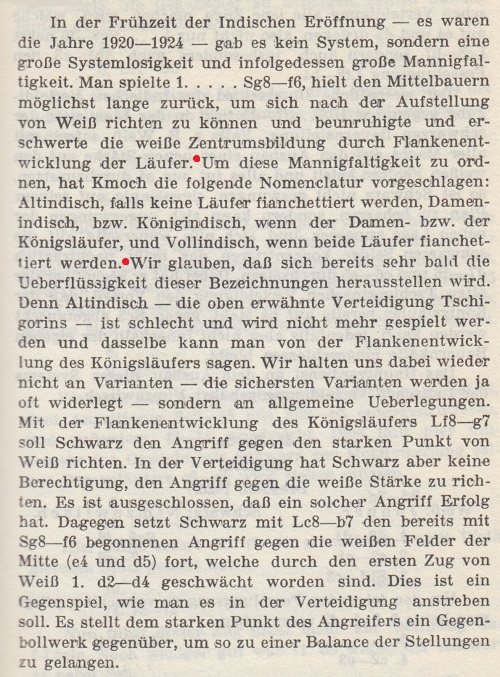
The corresponding passage on pages 137-138 of Masters of the Chess Board (London, 1933) had ‘All Indian’:

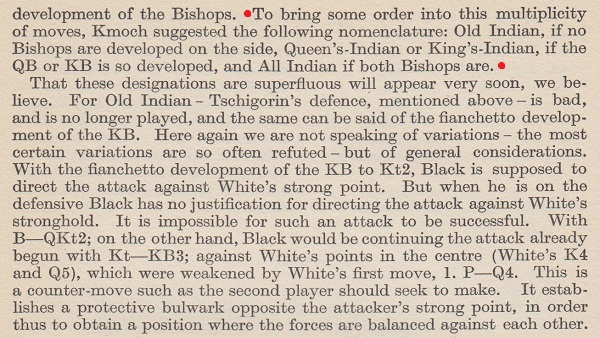
We add that the names for Indian openings were discussed, unwelcomingly, in a letter to the BCM from ‘Episcopus’ on pages 246-247 of the June 1932 issue:
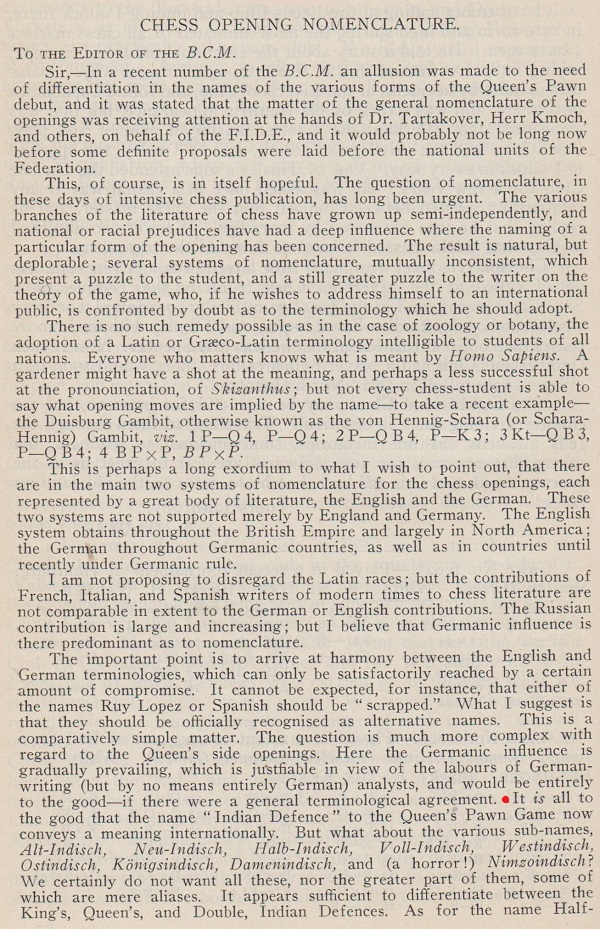
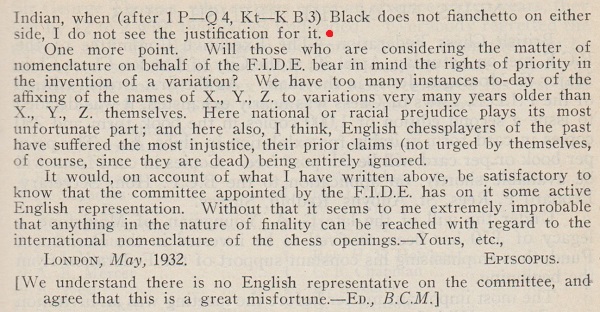
C.N. 3902 discussed FIDE’s attempts to standardize nomenclature, which culminated in the publication of Débuts du jeu d’échecs (Prague, 1934):
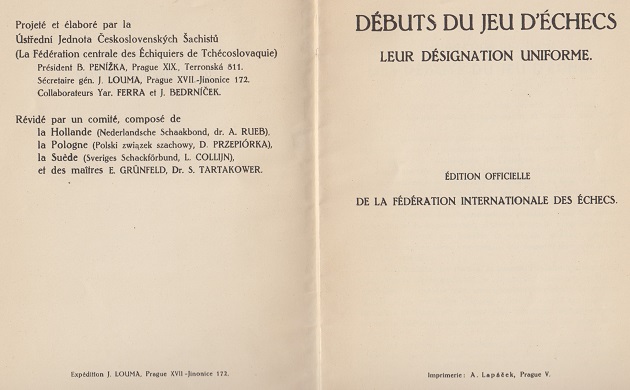
Pages 18-20 set out the fruits of the teamwork on the ‘Partie indienne’:
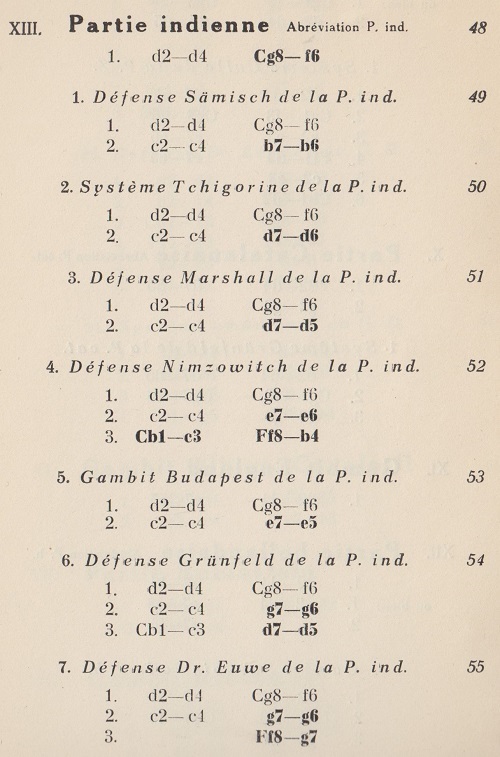


10059. Photographic archives (22)
Another photograph from our archives:
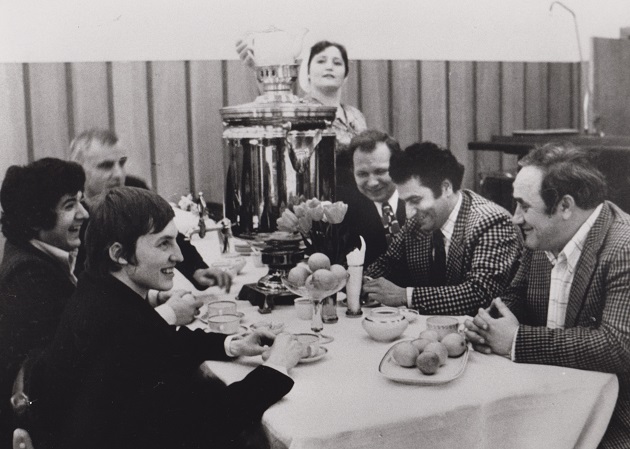
Can the less familiar diners be identified?
10060. Palle Ravn
From Lars Grahn (Malmö, Sweden):
‘When researching my book När Bent mötte Boris och sista dansen med Lizzie (which is being translated into English), I discovered that it was Palle Ravn (1928-2012) who introduced Bent Larsen to Lizzie Friis Jensen, inviting them to dinner at his home in 1961. Larsen married her on 11 May 1963.
Ravn’s life proved to be so fascinating that I now plan to write a book about him. He was Danish champion in 1957, and the same year he won against Portisch at the Student Olympiad in Reykjavik. He played a fine draw against Petrosian at the 1958 Olympiad in Munich, but after that event he more or less left the chess world.
Ravn spent almost nine months in Paris (August 1955 to April 1956) studying French, and nine months in Leningrad (1963) studying Russian. He participated in tournaments in Paris in 1953 (1st Popel, 4th Ravn, 8th Tartakower) and in 1955 (1st Tartakower, 4th Ravn). The latter was Tartakower’s last tournament, but although I have all the games I have found no reports on the event. Details are also scarce regarding Paris, 1953.
Any assistance with information on these matters or other points relating to Palle Ravn will be much appreciated.’
10061. Seeing ahead (C.N. 10035)
The article by Lajos Steiner referred to in C.N. 10035 (Chess World, 1 December 1947, pages 265-266):
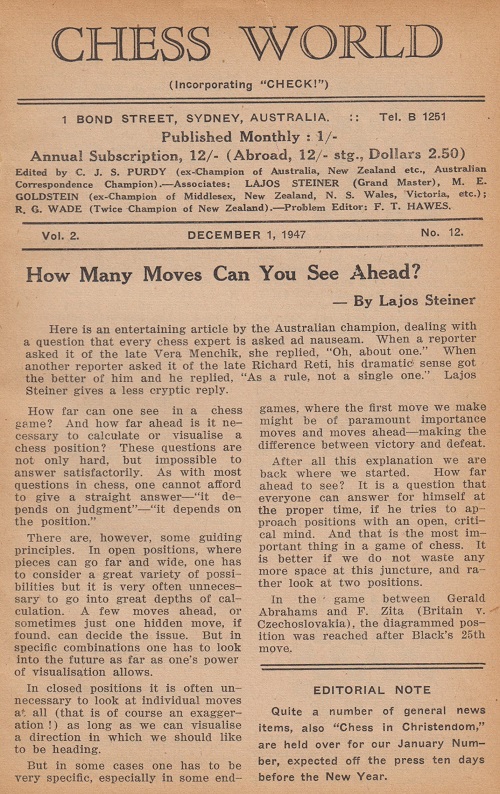
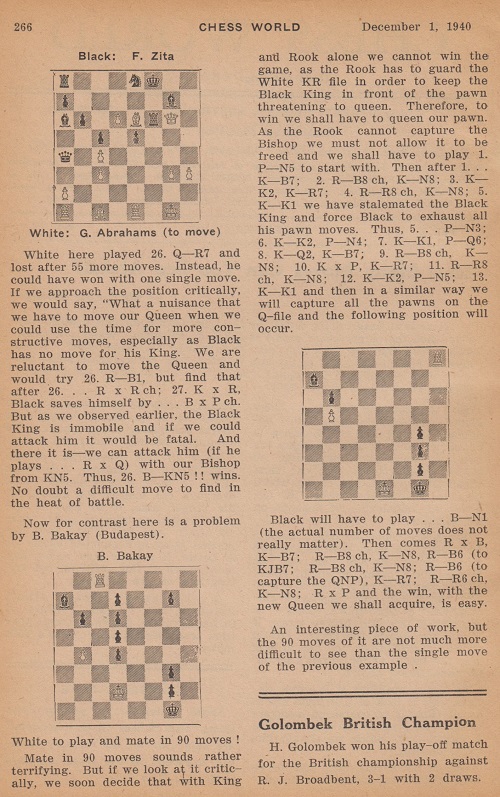
The details on where Béla Bakay’s mate-in-90 problem first appeared have not yet been found.
10062. Ilmar Raud
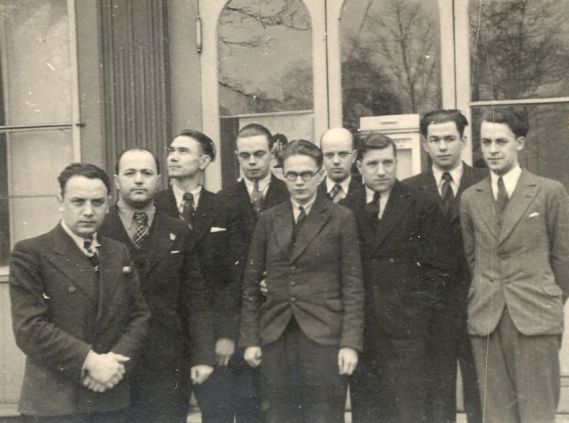
This photograph, reproduced from an Estonian webpage on Ilmar Raud (1913-41) with the permission of the site-owner, Margus Sööt, has been drawn to our attention by Thomas Ristoja (Helsinki). He believes that the picture may have been taken in Munich in 1936 and identifies (from left to right) 1 Vladimir Petrov; 2 Isakas Vistaneckis; 4 Osmo Kaila; 5 Ilmar Raud. Can the others be named?
10063. Kasparov v Korchnoi, Pasadena, 1983 (C.N. 10004)
Bruce Monson (Colorado Springs, CO, USA) notes that two photographs accompanied a report in the Los Angeles Times, 7 August 1983, pages 1 and 7. Better copies are sought.

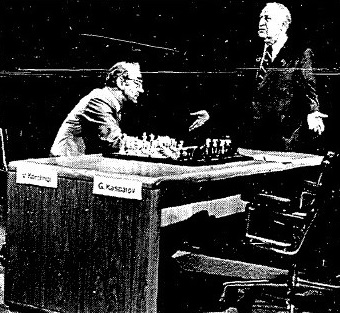
10064. Alexander on Réti
From C.H.O’D. Alexander’s column in the Sunday Times Magazine, 6 September 1970, page 38:
‘If you want to know what chess is about – or at least one of the things that it is about – you still can’t do better than read those magic books of the Twenties [sic] by Richard Réti: Modern Ideas in Chess and Masters of the Chess Board (published by G. Bell).’
The article concluded:
‘... when you have read Réti you will find that you have had your chess horizons widened without noticing it and you will be able, at least partially, to see the modern masters through Réti’s eyes.’
10065. Henry Albert Reeves
From Hans Renette (Bierbeek, Belgium):
‘An interesting amateur chessplayer of the nineteenth century was Henry Albert Reeves. The Ancestry website has a database entitled “India, Select Births and Baptisms, 1786-1947” which gives 3 August 1840 as his date of birth, Howrah (part of Calcutta) as his birth-place and 21 March 1841 as the date of his baptism.
Reeves took part in several chess contests in 1859, and in a knockout handicap tournament at Purssell’s, London he was one of 13 participants to receive the odds of pawn and two moves from the top three players (Ernst Falkbeer, Henry Edward Bird and Hesketh Hughes). Reeves reached the final and was narrowly beaten by Falkbeer. Later that year he defeated Hughes in a match at the same odds. He also played a match at the Philidorian Chess Rooms against Daniel Harrwitz, again receiving the odds of pawn and two moves. Harrwitz won +5 –3 =2.
One of Reeves’ earliest published games:
“Mr B.”-Henry Albert Reeves
London (Purssell’s), 1859
Bishop’s Opening1 e4 e5 2 Bc4 Nf6 3 Nc3 Bc5 4 d3 b5 5 Bxb5 c6 6 Bc4 Qb6 7 Qe2 d5 8 exd5 O-O 9 Ne4 Nxe4 10 dxe4 Bxf2+ 11 Qxf2 Qb4+ 12 Bd2 Qxc4 13 Qf3 f5 14 exf5 Bxf5 15 Qb3
15...Qf1+ 16 Kxf1 Bd3+ 17 Ke1 Rf1 mate.
Source: Sunday Times, 6 March 1859, page 3.
Reeves withdrew from chess to concentrate on his studies and, later, his work as an orthopaedic surgeon. In 1876 he married Ellen Buckingham Mathews, a novelist who wrote under the pseudonym Helen Mathers.
In the mid-1880s Reeves became more active again in chess. He took part in a handicap tournament at the Divan, the first Congress of the British Chess Association and a tournament at the British Chess Club.
Henry Albert Reeves -Isidor Arthur Gunsberg
London (Masters’ Tournament, British Chess Club), 1886
Ruy López1 e4 e5 2 Nf3 Nc6 3 Bb5 a6 4 Ba4 Nf6 5 O-O Nxe4 6 d4 b5 7 Bb3 d5 8 dxe5 Be6 9 Bf4 Ne7 10 c3 Ng6 11 Bg3 Bc5 12 Kh1 h5 13 h4 Be7 14 Bc2 Bg4 15 Qe1 Nc5 16 Nbd2 Bxf3 17 Nxf3 Nxh4 18 Nd4 Ne6
19 f4 Nxd4 20 cxd4 g6 21 e6 Rh6 22 f5 g5 23 Qe3 Bf8 24 Rae1 fxe6 25 fxe6 Rf6 26 Qd3 Qe7 27 Rxf6 Qxf6 28 Bxh4 gxh4 29 Qh7 resigns.
Source: The Field, 3 April 1886, page 412.
Two games in which Reeves played the Schliemann Defence against the Ruy López:
Henry Edward Bird-Henry Albert Reeves
London (Simpson’s), 1892
Ruy López1 e4 e5 2 Nf3 Nc6 3 Bb5 f5 4 Qe2 fxe4 5 Bxc6 dxc6 6 Qxe4 Bd6 7 d4 Nf6 8 Qe2 e4 9 Nc3 Qe7 10 Ng5 Bf5 11 h4 O-O-O 12 Be3 Rhe8 13 Qc4 Bb4 14 O-O-O h6 15 Nh3
15...Be6 16 Qf1 Bxc3 17 bxc3 Qa3+ 18 Kd2 Nd5 19 Ke1 Qxc3+ 20 Bd2 Qxc2 21 Rc1 Qxa2 22 Qc4 Qxc4 23 Rxc4 e3 24 White resigns.
Source: Standard, 11 July 1892, page 7.
Amos Burn-Henry Albert Reeves
London (Purssell’s), 1896
Ruy López1 e4 e5 2 Nf3 Nc6 3 Bb5 f5 4 Qe2 fxe4 5 Qxe4 Nf6 6 Qe2 e4 7 Ng5 d5 8 f3 Bd7 9 Bxc6 Bxc6 10 O-O Bc5+ 11 Kh1
11...O-O 12 Ne6 Qd6 13 Nxf8 Rxf8 14 Nc3 exf3 15 gxf3 d4 16 Nd1 Ng4 17 Ne3
17...Rxf3 18 White resigns.
Source: Nottinghamshire Guardian, 16 May 1896, page 7.
Reporting Reeves’ death on page 5 of the Sunday Times, 25 January 1914, Louis van Vliet stated (with regard to a tournament won by Teichmann):
“In 1896, as ‘Dr Farrow’, Mr Reeves entered for a tournament at ‘Simpson’s’ with the late H.E. Bird, F.J. Lee, and Teichmann, Müller Fenton, van Vliet, and several strong amateurs, for the express purpose of testing his variations in actual practice. But sad to say, he got very little chance, as with the exception of Bird, who had the courage of a lion, no-one ventured to play the Ruy López against him.”’
We add a few items about Reeves, beginning with his obituary on page 8 of the Times, 20 January 1914:
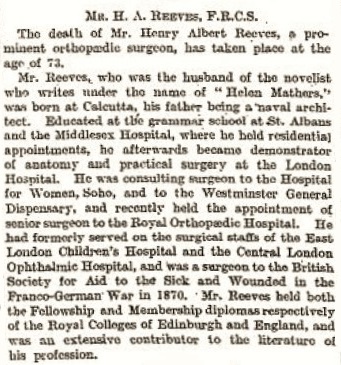
A detailed article was published on page 227 of the British Medical Journal, 24 January 1914. There was no obituary in the BCM, but page 158 of the March 1914 Chess Amateur had a brief notice:
‘Death of Mr H.A. Reeves
This distinguished surgeon was one of a group of talented London chessplayers who attained a high degree of proficiency, and whose death has caused much regret. A great deal of his leisure was spent over the board, in which he found valuable recreation after his trying and anxious work in the London and Orthopaedic Hospitals.’
Reeves was featured in the ‘Portrait Gallery’ of the Chess Monthly, October 1892, pages 33-34:
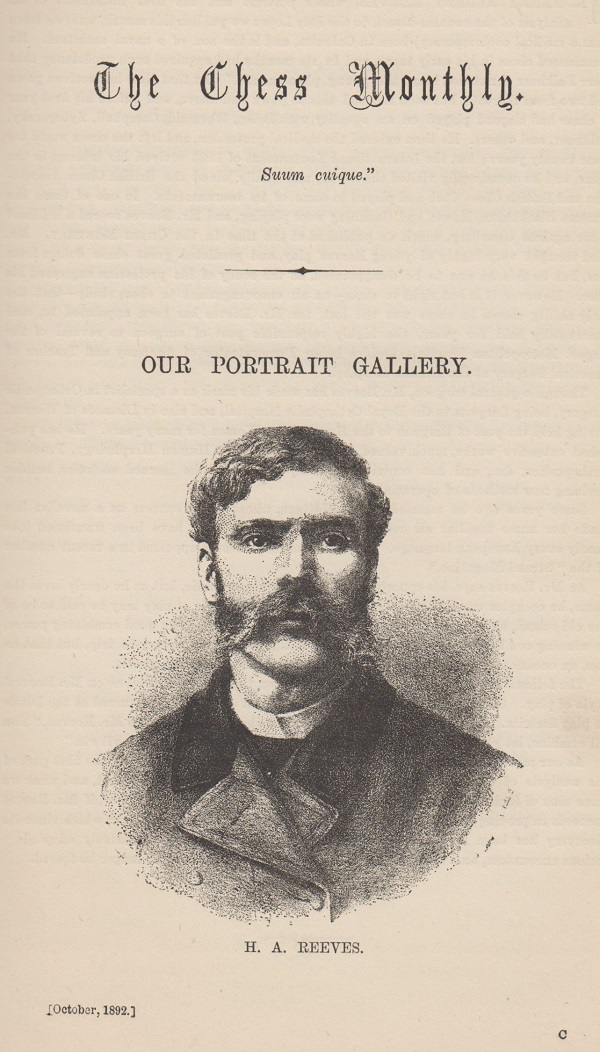
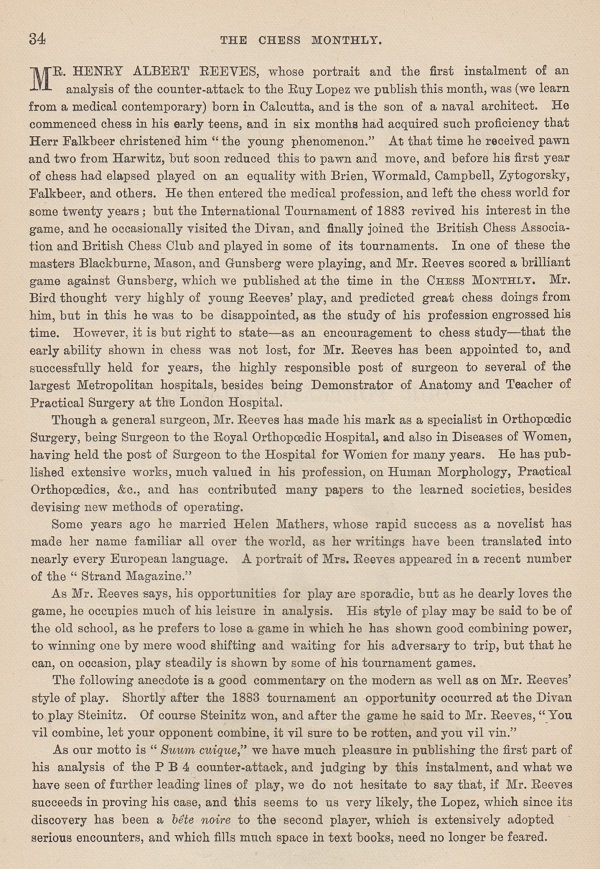
Reeves’ articles on 1 e4 e5 2 Nf3 Nc6 3 Bb5 f5 appeared in several issues of the Chess Monthly, and material was later presented by, in particular, George S. Carr. Over a period of nearly four years there were dozens of pages of text, analysis and tables on the Schliemann Defence.
The Burn v Reeves game given by Mr Renette was annotated by Richard Forster on page 458 of Amos Burn A Chess Biography (Jefferson, 2004), the score being taken from van Vliet’s column on page 20 of the Sunday Times, 1 February 1914.
The antepenultimate paragraph of the Chess Monthly text shown above has a notably early occurrence of ‘wood shifting’ (see the entries for that term in the Factfinder). The Steinitz ‘You vil combine’ remark (cf. C.N. 9894) in the penultimate paragraph was quoted in an item about Reeves on page 187 of the November 1929 American Chess Bulletin:

As discussed in Chess and Poetry, Wordsworth Donisthorpe’s ‘British Chess Club Alphabet’ on pages 138-139 of the January 1895 Chess Monthly referred to Reeves’ theoretical and surgical prowess:
‘R stands for Reeves, whom the public entrusts,
With the busting of openings and opening of busts.’
10066. The English Opening (C.N. 9166)
A note by Potter and Steinitz concerning 1 c4:
‘This move, when made by the first player, constitutes what is called the “English Opening”. It is calculated to bring about positions in which each side is soon thrown upon its own resources; but, if met by a proper defence, it is doubtful whether the first player should gain any advantage by its adoption.’
Sources: page 375 of the 18 April 1874 edition of The Field and page 89 of the May 1874 issue of the City of London Chess Magazine.
C.N. 9166 asked for instances during Howard Staunton’s lifetime of 1 c4 being called the English Opening on the basis of his espousal of the move. None having yet been found, we give below a slightly later citation. It is a note by G. Reichhelm about 1 c4 in a Delmar v Brewer correspondence game on page 362 of the American Chess Journal, June 1879 (annotations reproduced from page 4 of the Hartford Weekly Times, 19 June 1879):
‘Now justly called “the English opening”, it having been introduced by the great English champion, Staunton.’
10067. ¿Juguemos al ajedrez?
Four of the cartoons in the anonymous book ¿Juguemos al ajedrez? (Barcelona, 1947), whose front cover was shown in C.N. 6329:
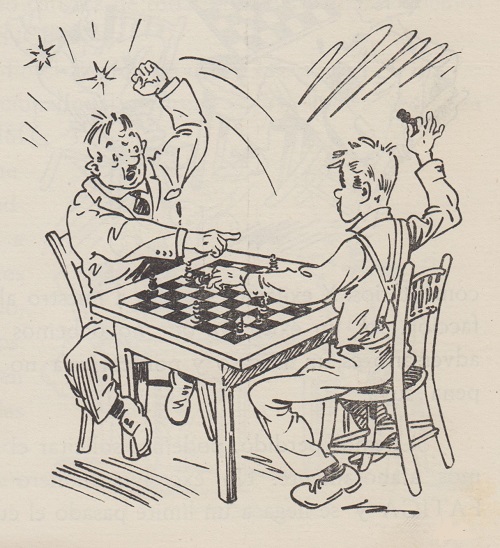
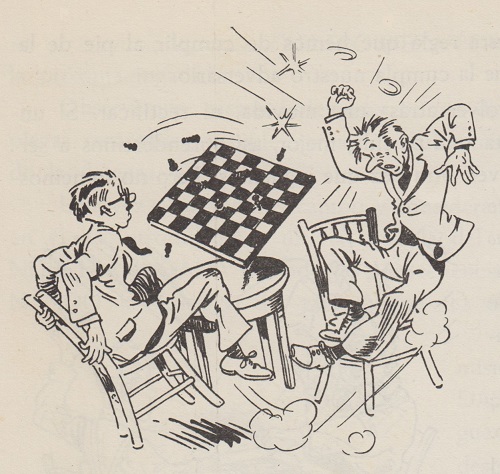
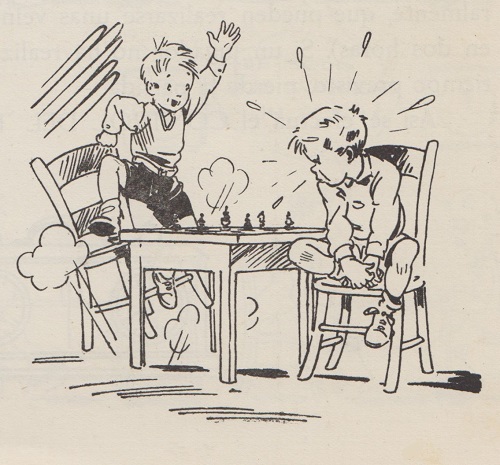
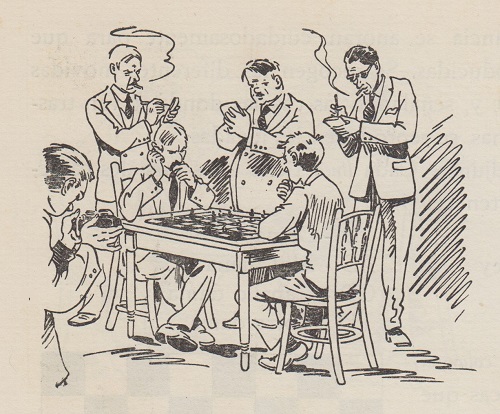
Towards the end of the book – the pages are unnumbered – the Immortal Game was shown. Anderssen’s nationality was given as English, and his opponent was misnamed (‘... entre los grandes maestros Anderssen (inglés) y Kiesevitzki (ruso)’). The same mistakes occur in connection with the musical composition La Inmortal by Ferrer Ferran.
10068. Monticelli v Horowitz
Leonard Barden’s Evening Standard column of 4 August 2016 gave this position from Mario Monticelli v Al Horowitz, Syracuse, August 1934:
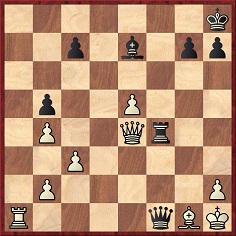
Black to move
Can the full game-score be found?
The conclusion was published on page 329 of The Personality of Chess (New York, 1963), which Horowitz co-wrote with P.L. Rothenberg:
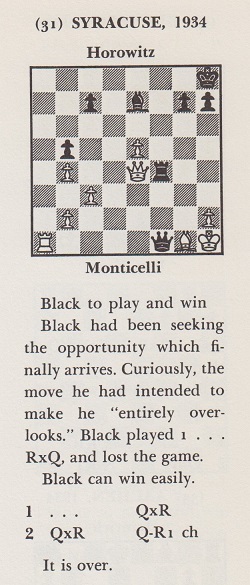
From page 339 of the November 1964 Chess Review (edited by Horowitz), in an article by Daniel Fidlow:

10069. Name-dropping
Writers who find the chess world claustrophobically small often go for a broad sweep, i.e. big-picture waffle with an abundance of non-chess name-dropping. If, for instance, the subject is genius, Leonardo da Vinci is always handy. The dual advantage – for the writer, if no-one else – is that broad sweepings can be redacted at speed without the need to know anything and, on account of their vagueness, without the risk of confutation.
Pages 85-86 of Famous Chess Players by Peter Morris Lerner (Minneapolis, 1973) devoted about 20 lines to a hazy comparison between Bobby Fischer and Isaac Newton.
10070. Philidor engraving (C.N.s 10026 & 10057)
Manfred Mittelbach (Cape Town) notes the discussion on pages 77-79 of a book mentioned in C.N. 6868, François André Danican Philidor La culture échiquéenne en France et en Angleterre au XVIIIe siècle by Sergio Boffa (Olomouc, 2010).
Our correspondent wonders whether the picture of Philidor’s blindfold display was published in any chess book prior to A Century of British Chess by P.W. Sergeant (London, 1934). It appeared there opposite page 22 with the acknowledgement ‘From an engraving, by kind permission of the City of London Chess Club’.
10071. William Harris
From John Townsend (Wokingham, England):
‘Your feature article on Alexander McDonnell mentions a letter to the Chess Player’s Chronicle (1843, pages 11-12) written by William Harris, of Richmond. In C.N. 10057, John Keeble’s 1926 BCM article alluded to this William Harris as an Australian, who had come to England in 1842 to see Philidor’s grave.
No source for that was indicated by Keeble, and it conflicts with other information about Harris. It was noted in C.N. 5216 that Harris’s place of birth was entered on the 1851 census as Shelton, Bedfordshire, and both the 1861 census (National Archives, RG 9/951, f. 132) and the 1871 census (National Archives, RG 10/1497, f. 159) concur that Shelton was his native place.
The parish register of Wollaston, Northamptonshire, contains an entry for the marriage of William Harris on 31 December 1840 to Ann Harris Walker, in which he was described as a druggist of Richmond, Surrey, and his father was named as Henry Harris, a farmer.
The couple lived for some years in Hill Street, Richmond, and had several children, most of whom were christened at the parish church of Richmond. William Harris’s enthusiasm for chess history is reflected in the choice of the unusual forename of Philidor for one son, i.e. William Alfred Philidor Harris, who was christened there on 15 March 1848 (although the name was misspelt as “Phillidore” in the parish register entry).
By the time of the 1861 census, William Harris had moved to Wollaston, and it is there that the National Probate Calendar records that William Harris, farmer, died on 5 March 1881, the administration of his personal estate of £1,100 being granted to his son, William Alfred Philidor Harris.’
10072. Chess Results
C.N. 9739 mentioned that the absence of sources in Chess Results, 1747-1900 by Gino Di Felice (Jefferson, 2004), as had been noted in C.N. 3594, was corrected later in the series, starting with Chess Results, 1941-1946 (Jefferson, 2008).
A source is helpful in this case, from page 291 of Chess Results, 1956-1960 (Jefferson, 2010):
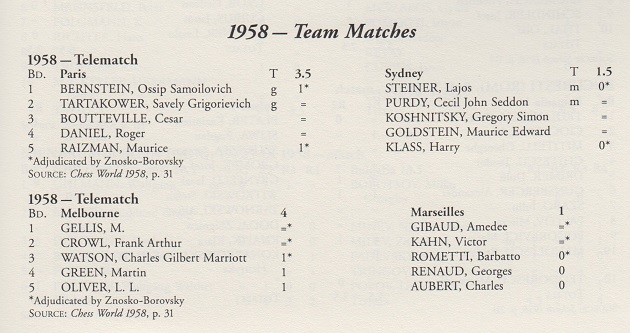
Below is what was published in the Australian magazine in 1958:
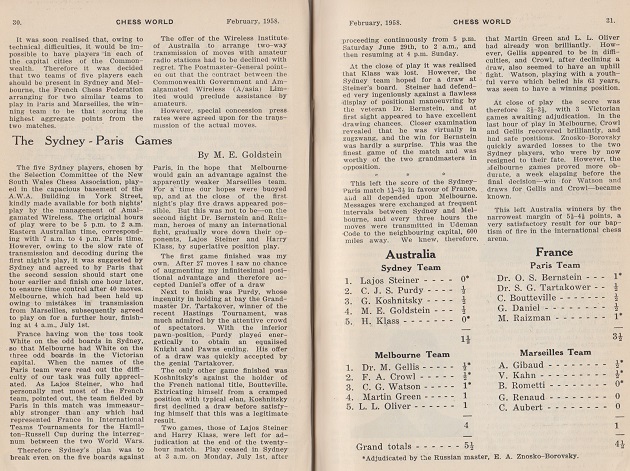
This was not a topical report but an historical article on matches played in 1946. Tartakower died in 1956.
10073. Syracuse, 1934 (C.N. 10068)
Gerard Killoran (Ilkley, England) notes page 19 of the Syracuse Journal, 23 August 1934:
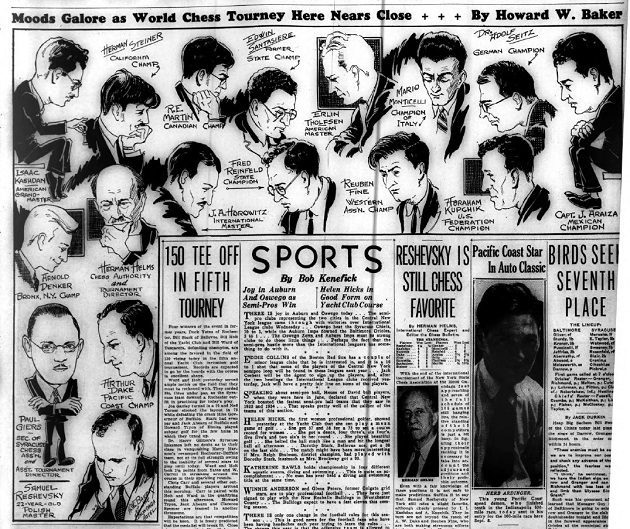
The newspaper can be viewed online,
and the above page is file number 6445. [Link no
longer working.]
1 e4 e5 2 Nf3 Nc6 3 Bb5 a6 4 Ba4 Nf6 5 O-O b5 6 Bb3 Nxe4 7 d4 d5 8 dxe5 Be6 9 c3 Be7 10 Be3 Na5 11 Nd4 Nxb3 12 axb3 Qd7 13 b4 f5 14 f3 Ng5 15 Nd2 O-O 16 f4 Ne4 17 N2b3 Rfc8 18 g4 Rf8 19 Nxe6 Qxe6 20 Nd4 Qg6 21 Nxf5 Rxf5 22 Qxd5+ Kh8 23 Qxa8+ Rf8 24 Rxa6 Qxg4+ 25 Kh1 Qe2 26 Qxe4 Qxf1+ 27 Bg1 Rxf4 28 Ra1 Rxe4 29 Rxf1 Rxe5 30 Bd4 Rg5 31 Re1 Bf8 32 Re8 Rf5 33 Bc5 Kg8 34 Kg2 g5 35 Rc8 Kg7 36 Rxc7+ Kg6 37 Rc6+ Kh5 38 b3 Bg7 39 c4 bxc4 40 bxc4 Rf4 41 Bd6 Rd4 42 b5 Kg4 43 h3+ Kf5 44 b6 Rd2+ 45 Kf1 Ke4 46 b7 Kf3 47 Bb4 Rd1+ 48 Be1 Rb1 49 Rc7 Be5 50 Rf7+ Bf4 51 c5 Ke4 52 Rxf4+ gxf4 53 c6 Ke3 54 c7 ‘1-0’.
As ever in such cases, confirmation from a written source is desirable.
10074. Two types of player
From page 387 of the Chess Amateur, October 1911:
‘The two contrasting types of player are as much in evidence as ever. On the one hand, the man who “never looks at a book”, but plays by the light of nature and the experience gained by long practice, and who usually gets himself into a tangle in the opening, spends the middle-game in trying to put himself straight, and very often manages to win what ought to be a lost endgame; and, on the other hand, the man who knows his openings (more or less) by heart, plays perfect “book” for a dozen moves, obtains a vastly superior position, and then, too often, loses all his advantage by half-a-dozen aimless moves in the middle-game, having a hard fight to make a draw out of a game he ought easily to have won. They display the profoundest scorn for one another, these two types, whereas, if they would borrow one another’s virtues instead of vituperating one another’s vices, their play would be much stronger. If every “practical chessplayer” would remember that experience is still experience when it is put into print, and would work through the C.A. Games Department; and if the book man would realize that the opening is only a small part of the game, and would study “Winning Positions”, “Endgames” and “Endings”, there would be a revolution in the standard of play among the rank and file – for these remarks are not intended for the high and mighty individuals to whom we look up as “top-board men”, but for the private soldiers of the League army, who are ready and anxious to improve their play, but possibly do not quite appreciate the best means of doing so.’
10075. Backward pawns
From Lasker v Capablanca, Moscow, 3 June 1936:

‘“What about the backward pawn?”, shrieks the pious student, brought up on sound positional principles. The answer is that there ain’t goin’ to be no backward pawn.’
That remark by C.J.S. Purdy was quoted on page 217 of The Immortal Games of Capablanca by Fred Reinfeld (New York, 1942) and on pages 259-260 of Capablanca’s Best Chess Endings by Irving Chernev (Oxford, 1978). Neither book mentioned the source: Purdy’s annotations on pages 283-284 of the Australasian Chess Review, 8 October 1936.
The game continued 20 Nh5 Qb7 21 Bg5 f6 22 Be3 Nc7 23 Qd1 Rd8 24 Rd2 Kh8 25 a3 Rbc8 26 Bf2 d5.
A game with the same theme was annotated by Purdy on pages 49-50 of Chess World, February 1957:
Emanuel Basta – Ortvin Sarapu
Melbourne Olympic Tourney, 1956-57 (round four)
Benoni Defence
1 d4 Nf6 2 c4 c5 3 d5 e6 4 Nc3 exd5 5 Nxd5 Nxd5 6 Qxd5 Be7 7 Nf3 Nc6 8 e4 O-O 9 Be3 d6 10 Qd2 Re8 11 Bd3 Bf6 12 O-O Qb6 13 Rab1 Bg4 14 Ne1 Ne5 15 f3 Be6 16 b3 Rad8 17 Bf2 h6 18 Rd1 Qa6 19 Be2 Nc6 20 Bd3 Nb4 21 a4 Qb6 22 Rb1 Bg5 23 f4 Bf6 24 Nf3
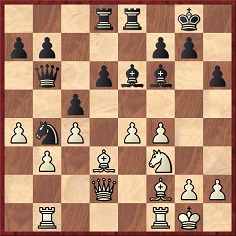
24...d5 25 exd5 Bxd5 26 cxd5 Rxd5 27 Rfe1 Red8 28 Nd4 Nxd3 29 Qxd3 Bxd4 30 Bxd4 Rxd4 31 Qc2 Rxf4 ‘and wins’.
In his introduction Purdy referred to ‘the extraordinary piece of play’, adding that the game ...
‘... illustrates the modern tendency to submit to a backward pawn on Q3 or K3, anathema to a classicist. The commonest example is the ...P-K4 line in the Sicilian Defence.
If the backward pawn cannot be attacked by minor pieces, it need not prove a handicap in the middle-game. Meanwhile it serves to support something on Q4 or K4.’
Purdy gave 24...d5 two exclamation marks and commented as follows on Sarapu’s play:
‘Because this looked permanently impossible, White had never bothered to think of it. But his 20th, 22nd and 24th moves have combined to make the impossible possible – and decisive.’
10076. Monticelli v Horowitz (C.N.s 10068 & 10073)
Peter Anderberg (Harmstorf, Germany) notes that the Monticelli v Horowitz game was published on page 785 of L’Echiquier, October-November 1934:
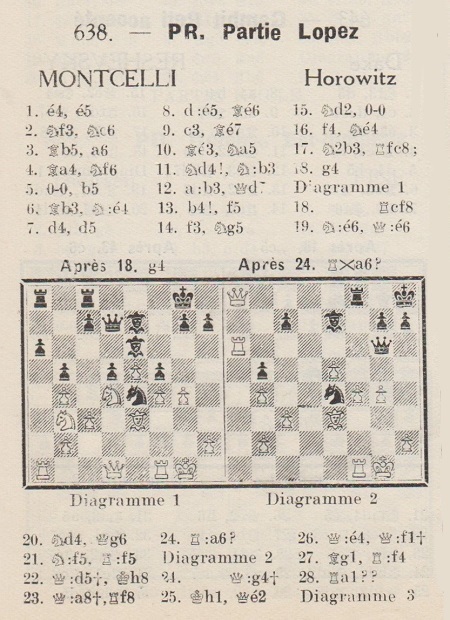

10077. How to castle
From page 2 of Bell’s Life in London, 26 July 1835:
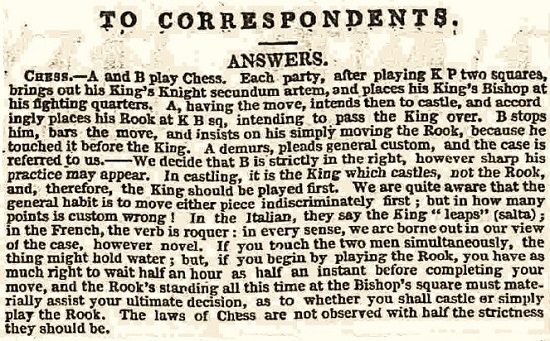
A simplified French translation/paraphrase was published on pages 261-262 of Le Palamède, 1837 with this dissenting remark (backed up with no reasoning):
‘Nous ne partageons pas en cette occasion l’opinion du rédacteur du Bell’s Life in London, et nous croyons que le joueur qui roquera en touchant d’abord sa tour, puis touchant immédiatement son roi, ne sera point répréhensible.’
Wanted: other claims, from any period, that castling does not require the king to be moved first.
10078. Staunton’s Handbook
The Chess-Player’s Handbook by Howard Staunton (London, 1847) was widely copied, with or without acknowledgement and often without thought.
An example, concerning J’adoube, is provided by page 36, in the section entitled ‘The Laws of the Game’:

A search in Google Books shows that Staunton’s text was reproduced verbatim in a number of publications, even though the first part of Law IX is obviously faulty.
The rule in question (from ‘Laws of Chess, as lately revised by a Committee of the London Chess Club’, published on pages 266-269 of the Chess Player’s Chronicle, 1842):

In the Handbook the fourth word, ‘take’, was subsequently corrected to ‘touch’. In which edition was the amendment first made?
10079. Hamburg, 1910
From Jan Kalendovský (Brno, Czech Republic) come two photographs published on page 4 of Světozor, 5 August 1910:
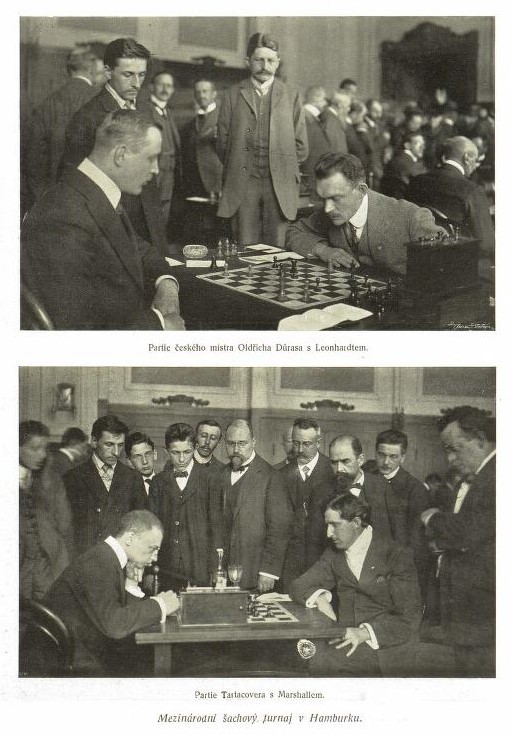
Larger versions: Důras v Leonhardt; Tartakower v Marshall.
10080. Hastings, 1895
In addition to the famous group photograph of Hastings, 1895 – e.g. opposite page 48 of Hundert Jahre Schachturniere by P. Feenstra Kuiper (Amsterdam, 1964) – there is a less familiar picture discussed in C.N.s 4663, 5832, 5836, 5841, 7354 and 7879.
Information is requested on a further shot which was mentioned by Robert J. Buckley in an article in the Birmingham Mercury reproduced on page 10 of the July 1899 American Chess Magazine:
‘Marco claimed to have been photographed with us in 1895 at Battle Abbey, near the spot where Harold, last of the Saxon kings, fell with a Norman arrow in his brain. We never saw this masterpiece of photography, but it hangs, we are told, in a certain chamber in Vienna, where it doubtless adds to the glories of the Danube.’
In an 1895 article shown in C.N. 7879 Buckley wrote that the players’ excursion to Battle Abbey had ‘the usual group-photographing inseparable from such occasions’.
10081. How to castle (C.N. 10077)
Joose Norri (Helsinki) mentions the game Miles v Polugayevsky, Tilburg, 1985. Miles’ notes on pages 19-20 of the 11/1985 issue of New in Chess included the following:
‘19...O-O-Oh!?
Or to be more precise 19 O-O-O, but moving the rook first.’
‘19...O-O-Oh!?’ was amended to ‘19...O-O-O-a!?’ when the annotations were given on pages 179-182 of the anthology Tony Miles: ‘It’s Only Me’ compiled by Geoff Lawton (London, 2003). The episode was also discussed on pages 48-49 of De Rochade by Robert Timmer (Venlo-Antwerp, 1994); see too pages 40-41 of the English edition, Startling Castling! (London, 1997).
10082. Frederick Orrett
The series of portraits by Frederick Orrett sent to us by Michael McDowell (Westcliff-on-sea, England) continues with William Shelley Branch and two incomplete pictures of Rudolf Spielmann:
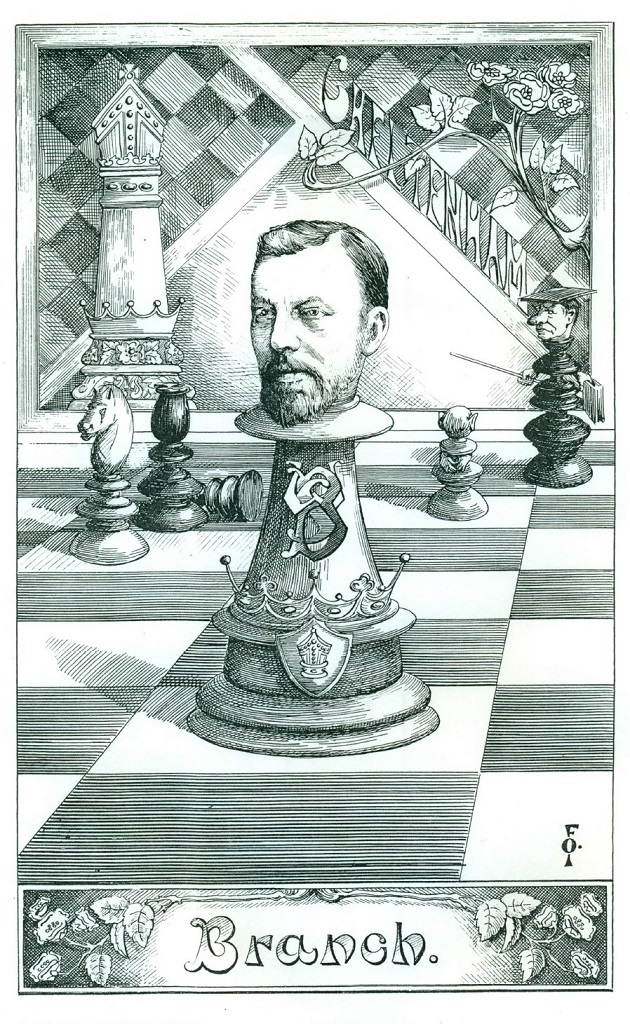

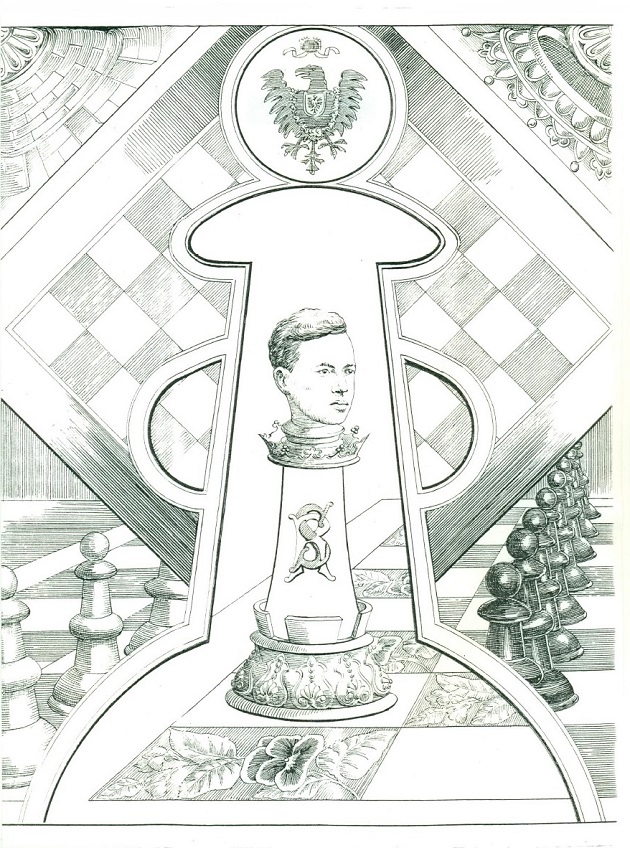
10083. Opening busts (C.N. 10065)
This couplet in Wordsworth Donisthorpe’s ‘British Chess Club Alphabet’ (from the January 1895 Chess Monthly, pages 138-139) was discussed in C.N. 10065:

Sean Robinson (Tacoma, WA, USA) would like to know the earliest occurrence of the term ‘bust’ in connection with opening theory.
10084. Busts!
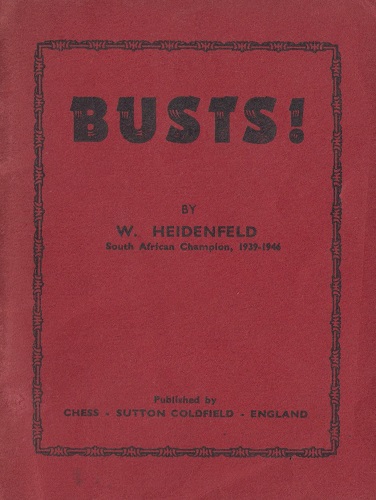
Busts! by Wolfgang Heidenfeld (Sutton Coldfield, 1947) measures only 12cm x 9cm and has 17 pages of text, but anything by Heidenfeld is worth reading. Some general comments from pages 3-4:
‘Chess is difficult enough at its simplest, and anybody, be he the greatest master, may fail to notice a hidden resource to a subtle and involved combination often extending over many moves. I entirely agree with players of the Tartakower or Kurt Richter school of thought, who maintain that a sacrifice – in Spielmann’s terminology a “real” as opposed to a “temporary” sacrifice – cannot simply be classed as incorrect if it induces the opponent to go wrong 90 times out of a hundred – even if subsequent analysis should be able to establish its objective unsoundness. For the practice of tournament play – and it is with such games, not with correspondence chess combinations, that I am concerned – the refutable combination need not be inferior to the abstractly correct combination. One may even go a step further. There may be cases where the 90% combination is preferable to the 100% one – when the latter combination would tax your own resources to such an extent that only a miracle could save you from losing your way under the time-limit. What is the good of the most brilliant and correct conception which yields, say, a sound pawn, when afterwards you are too exhausted to give sufficient attention to the resulting endgame and may lose, not only your hard-earned pawn, but perhaps the game? Chess is a fight, not a science, and men are men and not machines.’
10085. Nazi articles
Dominique Thimognier (Fondettes, France) reports that the Gallica site of the Bibliothèque Nationale de France has recently placed online a run of the Pariser Zeitung, the newspaper published during the Nazi occupation of France.
The anti-Semitic
articles which appeared under Alekhine’s name were
printed there in six parts, on 18, 19, 20, 21, 22 and 23
March 1941. The Gallica project lacks the first part in
the serialization, but the other five have been drawn
together in a file
by Mr Thimognier, together with an introductory note in
the 16 March 1941 edition.
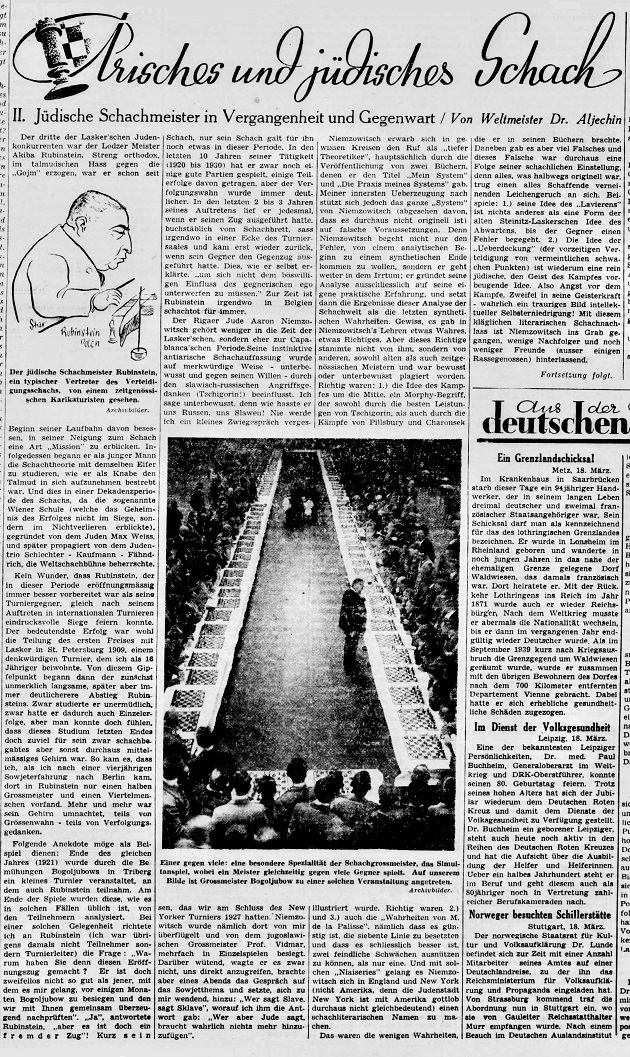
Pariser Zeitung, 19 March 1941, page 3
Our correspondent adds:
‘The newspaper’s chess column was published on Sundays and began on 16 February 1941. Some material was attributed to “A.L.”, who was identified on 23 March 1941 as A. Linder.
In a correction on page 6 of the 27 April 1941 edition the chess column stated that Schlechter was not Jewish:
From July to December 1941, games were usually annotated by Znosko-Borovsky. The reference to “Geleitet von Weltmeister Dr. Aljechin” was dropped with the 7 December 1941 column even though, strange to say, the content subsequently consisted solely of games annotated by Alekhine. In 1942 the column appeared only occasionally, and the last one that I have found is dated 17 May 1942.’
10086. Long and wrong (C.N.s 9260 & 10037)
Dan Scoones (Coquitlam, BC, Canada) recalls an article, ‘Analytical Overkill’, by Bent Larsen on pages 2-3 of the April 1972 issue of Chess Canada:
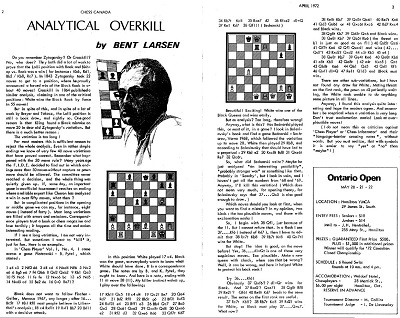
The article began:
‘Do you remember Zytogorsky? Or Crosskill? No, who does? They both did a lot of work to prove that the Lolli position with rook and bishop vs rook was a win (for instance: Kb6, Rd1, Bb5/Kb8, Rc7). In 1843 Zytogorsky took 22 moves to get to a position where he proudly announced a forced win of the black rook in about 40 moves. Crosskill in 1864 published a similar analysis, claiming in one of the critical positions: White wins the black rook by force in 55 moves.
But in spite of this, and in spite of a lot of work by Breyer and Takács, the Lolli position is still a book draw, and rightly so. One good reason is that Kling found a Black mistake on move 20 in dear old Zytogorsky’s variation. But there is a much better reason:
The variation is too long.’
From later in the article:
‘Most long variations are filled with errors and omissions. Correspondence players trust a book or chess magazine and lose terribly. It happens all the time and makes interesting reading.
If I see a long variation, I am not very interested. But sometimes I want to “kill” it, just for fun.’
After giving an example, Larsen commented:
‘Beautiful! Exciting! ... But as analysis? Too long, therefore wrong!’
The article concluded:
‘And remember: be sceptical when a variation is very long.’
10087. Boden
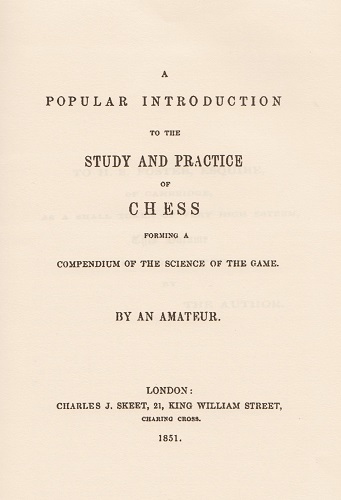
A selection of quotes from A Popular Introduction to the Study and Practice of Chess (London, 1851), a book by S.S. Boden published anonymously when he was in his mid-twenties:
- ‘We advise the learner, whilst playing over games, continually to cover the printed move, and before looking at it, to consider well what he himself would have done in such position. He will thus see the superiority of a master’s play, and in peculiar or difficult situations this is especially useful.’ (Page 17. See too C.N. 9806.)
- ‘Beware how you think to play “fine”; we have repeatedly known players lose a dead won game by attempting to finish it off “in style”. A clumsy win is far better than a brilliant break down.’ (Page 23.)
- ‘Whilst a young player, do not commit yourself by criticizing aloud the moves of better chess-men. Every bad player seems to think himself quite competent to pass judgment on a loser’s game.’ (Page 24.)
- ‘It is not every player that can lose a hard fought game with perfect equanimity. Few things are more annoying, indeed, than repeated loss, but we cannot but agree with all authorities on the subject, and strongly advise you, however trying the defeat, never to lose your temper, if you can help it. Endeavour to take a beating with good humour, and fight in quiet to the last. It is better never to make any excuse whatever after losing – apologizing for your bad play in such terms as “darkness”, “rust”, “single oversight”, “that one slip”, “headache”, “dizziness”, “thinking of other things”, “bad men and board”, etc., etc., etc. will only make your opponent laugh in his sleeve, or hypocritically condole with you. If you are, from any cause, “off your play”, say so before beginning, and not after losing.’ (Page 25.)
- ‘For chess study, we have often found the mental powers keenest, and in best “cue”, before breakfast, or early in the morning, when unfatigued by the day’s exertions. Chess play immediately after meals is extremely injurious, calling the blood to the head, and interrupting digestion. No-one can play well just after a hearty dinner, and between skilful players we should think this as bad as giving the odds of a knight.’ (Page 26.)
- ‘In playing, never forget the Italian maxim, “Never make a good move without first looking out for a better”. This is the golden rule of chess.’ (Page 27. See the references under Damiano in the Factfinder.)
- ‘When you see a young player make all his moves in a fast rattle-dash style, suspect that he has been in the habit of beating very bad players, and will not be difficult to trip up.’ (Page 27.)
- ‘If only a chessling, beware how you talk chess (about Philidor, Staunton and gambits, for instance) before anyone who understands these matters. You cannot make half-a-dozen remarks without a good player’s being able to guess at your real skill. If you should explain to him how very well you used to play, and how many moves you used to calculate, when you practised every night with such and such a friend, who was quite a first-rate, or how fond you are of your knights, and how useless the rooks are, etc., etc., he will see directly that your chess is below zero.’ (Page 32.)
- ‘With respect to recording, most players have an amazingly better memory for the games they win than for those they lose.’ (Page 33.)
- ‘Learners will derive great improvement from playing
in unison with artists of higher skill in chess.
One circumstance which adds to their pleasantness is that in consultation games there is little compromise of reputation. Responsibility being divided, the player jealous of his fame does not, from his partner’s having had a hand in the affair, so much feel the being defeated – especially by a powerful league of opponents.’ (Page 37.)
- ‘Will not almost all good players agree with us in deeming our game of chess, as it now stands, and has stood for 300 years or more, to be matchless, unimproveable, consummate, perfect?’ (Page 38.)
- ‘It is a rather remarkable circumstance, with regard to the philosophy of chess attainments, that after a certain amount of study and practice a player arrives at his utmost possible pitch of skill, his ne plus ultra of chess force, which, no matter what be his advantages or industry, he cannot pass.’ (Page 44.)
- ‘Chess skill is not necessarily associated with any other particular talent, nor with general capacity. It seems to be an exclusive faculty, a talent sui generis. We do not mean to say that there is a chess “bump” yet to be pointed out in the head, but that great aptitude for chess results from a certain relative balancing of the mental powers, which need not produce a like excellence in any other pursuit. Eminent chess ability has been sometimes coupled with high powers in every other respect; sometimes with depth of mathematical thought – sometimes with logical keenness – sometimes with no other particular talent – sometimes with striking aptitude for the art of drawing – and remarkably often with the gift of music. Yet we cannot define the source or seat of chess talent; for, on the other hand, men of every other variety of great talent have found themselves, with all their efforts, unable to shine at chess.’ (Page 45.)
- ‘Be it remembered that ardent fondness for chess is no proof of uncommon talent or genius for the game. Stupid indeed must that intellect be which, after acquiring something of the science of the game, could neither appreciate nor admire its beauties. We never knew anyone decry chess, except the individual [who] happened to know less than nothing about it. In fact, where the game has been really entered into, there is, in the whole round of human enjoyments, none so fascinating, none which takes so firm and constant a hold on the mind, as chess play. There is no pleasure equal to that of the young chessplayer beginning really to understand the game. Chess, indeed, seems to possess every attraction that could possibly be concentrated in a purely intellectual exercise. The only danger is that of chess idolatry to young players. Young and clever amateurs are sure to be enthusiastic. Wherever there is a spark of chivalry in the character, or of logical activity in the mind, there will be intense admiration of the game of chess.’ (Page 47.)
- ‘A grand object in play is to gain time; hence you should, as much as possible, let your moves be continually attacking. An attack, or rather a series of attacking moves, keeps your opponent beneath you; therefore, ever have it in view thus to gain time, remembering that a counter-attack is the strongest species of defence. This forms a grand and most important matter, or rather principle, in chess tactics.’ (Page 135. See too the Factfinder for similar remarks about counter-attack being the strongest form of defence.)
10088. Boden on gambits
The previous item did not have the most famous quotation ascribed to S.S. Boden (about gambits giving a lost game), because there is no such remark in A Popular Introduction to the Study and Practice of Chess. However, Boden’s obituary on pages 167-168 of the February 1882 Chess Monthly is noteworthy:
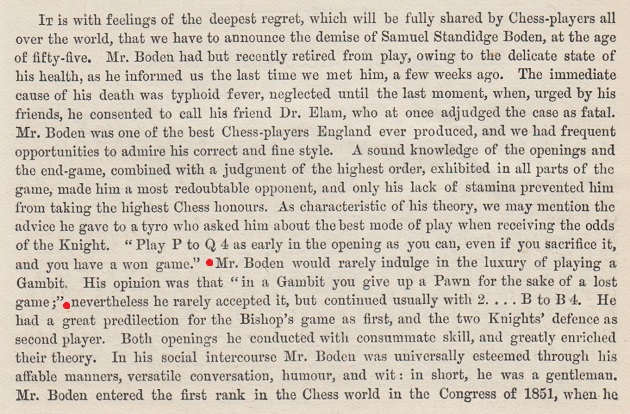

The most common wording of the dictum found nowadays is that given by Irving Chernev on page 112 of The Bright Side of Chess (Philadelphia, 1948):
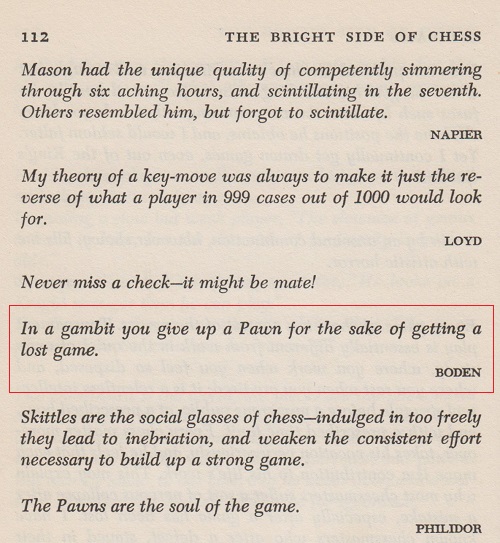
This extract also offers an answer to a matter raised in C.N. 9377: why the name Boden was given in connection with the ‘Never miss a check’ comment on page 37 of Impact of Genius by R.E. Fauber (Seattle, 1992). It appears to be yet another example of the confusion caused by the lay-out of epigrams in Chernev’s book. See, for instance, C.N. 3741 and, more generally, Chess: the Need for Sources.
10089. A site for chess bibliophiles
A website recommended is Chess Book Chats by Michael Clapham.
10090. Ostend, 1936
Wanted: a good-quality version of the Ostend, 1936 group photograph. We have only a copy of its publication on page 1 of the 9 May 1936 issue of the Swiss magazine Schach-Kurier:
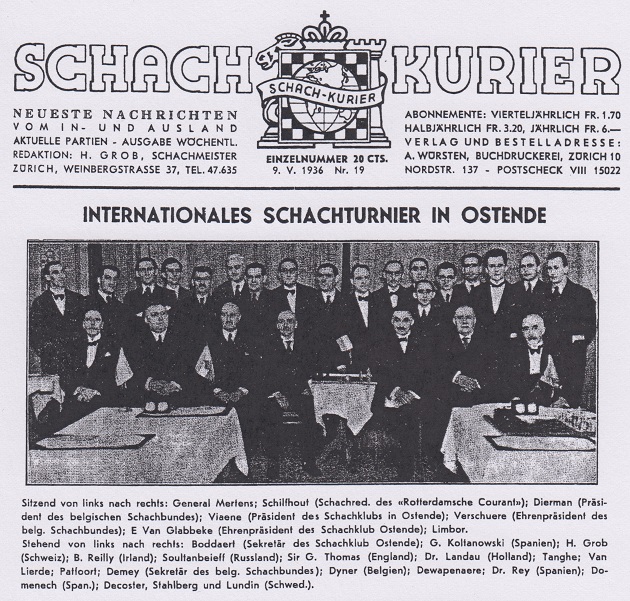
| First column | << previous | Archives [145] | next >> | Current column |
Copyright: Edward Winter. All rights reserved.
